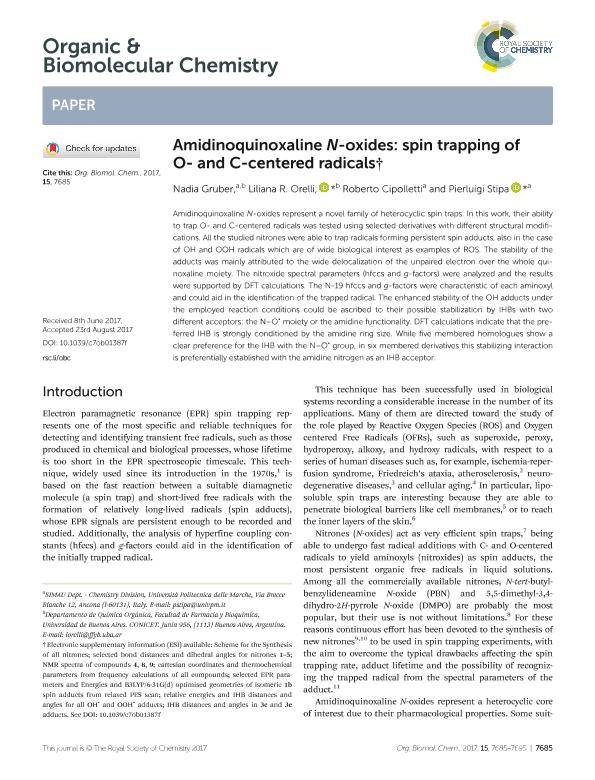Mostrar el registro sencillo del ítem
dc.contributor.author
Gruber, Nadia

dc.contributor.author
Orelli, Liliana Raquel

dc.contributor.author
Cipolletti, Roberto
dc.contributor.author
Stipa, Pierluigi

dc.date.available
2018-06-07T18:29:03Z
dc.date.issued
2017-09
dc.identifier.citation
Gruber, Nadia; Orelli, Liliana Raquel; Cipolletti, Roberto; Stipa, Pierluigi; Amidinoquinoxaline N-oxides: spin trapping of O- and C-centered radicals; Royal Society of Chemistry; Organic & Biomolecular Chemistry; 15; 36; 9-2017; 7685-7695
dc.identifier.issn
1477-0520
dc.identifier.uri
http://hdl.handle.net/11336/47721
dc.description.abstract
Amidinoquinoxaline N-oxides represent a novel family of heterocyclic spin traps. In this work, their ability to trap O- and C-centered radicals was tested using selected derivatives with different structural modifications. All the studied nitrones were able to trap radicals forming persistent spin adducts, also in the case of OH and OOH radicals which are of wide biological interest as examples of ROS. The stability of the adducts was mainly attributed to the wide delocalization of the unpaired electron over the whole quinoxaline moiety. The nitroxide spectral parameters (hfccs and g-factors) were analyzed and the results were supported by DFT calculations. The N-19 hfccs and g-factors were characteristic of each aminoxyl and could aid in the identification of the trapped radical. The enhanced stability of the OH adducts under the employed reaction conditions could be ascribed to their possible stabilization by IHBs with two different acceptors: the N–O˙ moiety or the amidine functionality. DFT calculations indicate that the preferred IHB is strongly conditioned by the amidine ring size. While five membered homologues show a clear preference for the IHB with the N–O˙ group, in six membered derivatives this stabilizing interaction is preferentially established with the amidine nitrogen as an IHB acceptor.
dc.format
application/pdf
dc.language.iso
eng
dc.publisher
Royal Society of Chemistry

dc.rights
info:eu-repo/semantics/openAccess
dc.rights.uri
https://creativecommons.org/licenses/by-nc-sa/2.5/ar/
dc.subject
Spin Traps
dc.subject
Nitrones
dc.subject
Epr
dc.subject
Ros
dc.subject
Dft
dc.subject.classification
Otras Ciencias Químicas

dc.subject.classification
Ciencias Químicas

dc.subject.classification
CIENCIAS NATURALES Y EXACTAS

dc.title
Amidinoquinoxaline N-oxides: spin trapping of O- and C-centered radicals
dc.type
info:eu-repo/semantics/article
dc.type
info:ar-repo/semantics/artículo
dc.type
info:eu-repo/semantics/publishedVersion
dc.date.updated
2018-06-07T14:24:20Z
dc.journal.volume
15
dc.journal.number
36
dc.journal.pagination
7685-7695
dc.journal.pais
Reino Unido

dc.description.fil
Fil: Gruber, Nadia. Università Politecnica delle Marche; Italia. Universidad de Buenos Aires. Facultad de Farmacia y Bioquímica. Departamento de Química Orgánica; Argentina. Consejo Nacional de Investigaciones Científicas y Técnicas; Argentina
dc.description.fil
Fil: Orelli, Liliana Raquel. Universidad de Buenos Aires. Facultad de Farmacia y Bioquímica. Departamento de Química Orgánica; Argentina. Consejo Nacional de Investigaciones Científicas y Técnicas; Argentina
dc.description.fil
Fil: Cipolletti, Roberto. Università Politecnica delle Marche; Italia
dc.description.fil
Fil: Stipa, Pierluigi. Università Politecnica delle Marche; Italia
dc.journal.title
Organic & Biomolecular Chemistry

dc.relation.alternativeid
info:eu-repo/semantics/altIdentifier/doi/https://dx.doi.org/10.1039/C7OB01387F
dc.relation.alternativeid
info:eu-repo/semantics/altIdentifier/url/http://pubs.rsc.org/en/Content/ArticleLanding/2017/OB/C7OB01387F
Archivos asociados
